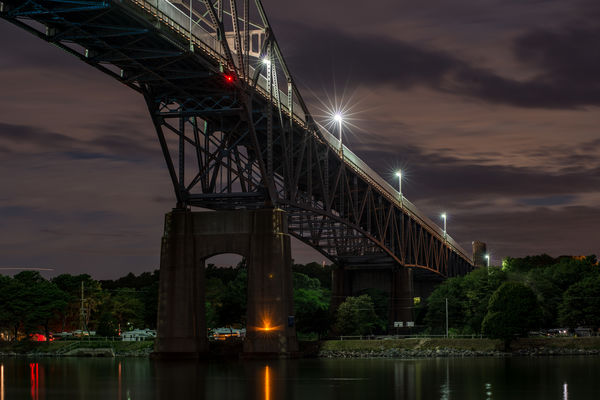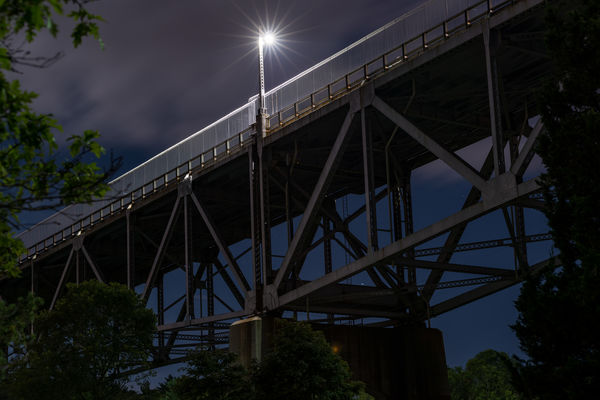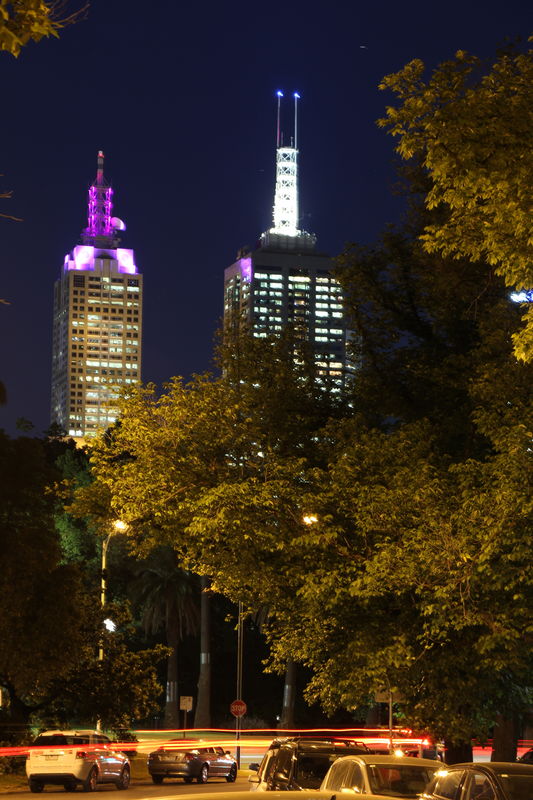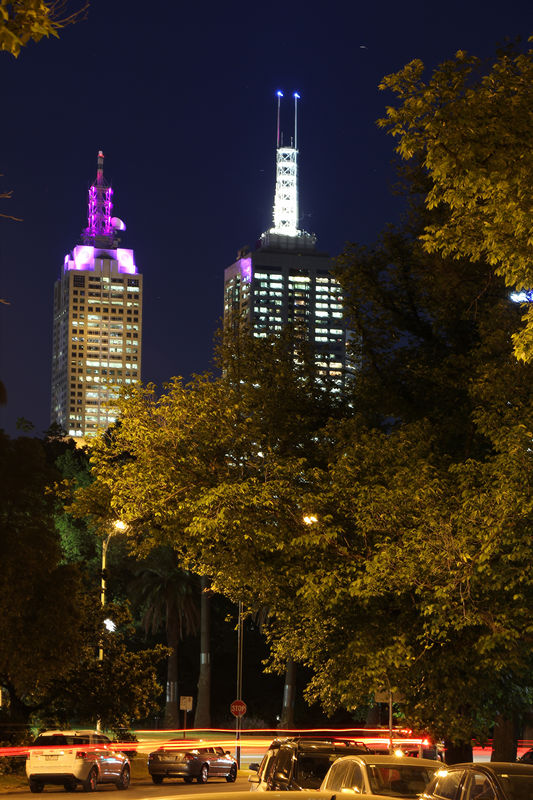How do you get it sharp
Dec 8, 2016 06:48:57 #
Camera stability is only as good as the weakest link in its support.
Further to tusketwedge's advice, it is interesting to watch the fully enlarged screen on a mirrorless camera for the period between pushing the button, and the shutter firing.
I'm sure that expert New World marksmen are aware of such effects!
On all but the most monumental tripods and camera-mounting interfaces, 2 seconds delay is probably not enough. Use ten seconds - or a remote release.
The top of a wall and a bean-bag can be good!
Further to tusketwedge's advice, it is interesting to watch the fully enlarged screen on a mirrorless camera for the period between pushing the button, and the shutter firing.
I'm sure that expert New World marksmen are aware of such effects!
On all but the most monumental tripods and camera-mounting interfaces, 2 seconds delay is probably not enough. Use ten seconds - or a remote release.
The top of a wall and a bean-bag can be good!
Dec 8, 2016 07:18:05 #
Haydon wrote:
The IS is trying to compensate for a handheld shot... (show quote)
Photoshop elements 14 under enhancements (camera shake)!
Dec 8, 2016 15:05:17 #
stevenh0027 wrote:
Hi all, br I tried to take some photos of some bui... (show quote)
These two images were taken with a 30 sec exposure, no shutter delay, no mirror lockup, no remote cable release, no live view previewing. Finger on the shutter, arm draped on the lens, Feisol CT3472, Arca-Swiss Z1 ball head. Pretty solid platform though hardly monumental. The tripod collar on the lens is close to useless, which is why I stabilize the lens with my left hand/arm draped over the lens. In the second image you can see star trails.
Nikon D800, Nikkor 80-200mm F2.8 AF-D, 30 secs, F6.3, ISO 100

(Download)
Nikon D800, Nikkor 80-200mm F2.8 AF-D, 30 secs, F6.3, ISO 100

(Download)
Dec 8, 2016 16:57:41 #
Gene51 wrote:
These two images were taken with a 30 sec exposure, no shutter delay, no mirror lockup, no remote cable release, no live view previewing. Finger on the shutter, arm draped on the lens, Feisol CT3472, Arca-Swiss Z1 ball head. Pretty solid platform though hardly monumental. The tripod collar on the lens is close to useless, which is why I stabilize the lens with my left hand/arm draped over the lens. In the second image you can see star trails.
Why do you feel the need to post your images as responses to all threads? You must be horribly insecure or in desperate need for validation of some sort. Geesus.
Dec 8, 2016 17:00:13 #
stevenh0027 wrote:
Hi all, br I tried to take some photos of some bui... (show quote)
You must assure that focus is dead on and then disable the things that adversely affect sharpness. Use of stabilization while camera is on a tripod may be one of those things.
Dec 8, 2016 18:05:19 #
Jim Bob wrote:
Why do you feel the need to post your images as responses to all threads? You must be horribly insecure or in desperate need for validation of some sort. Geesus.
A picture is worth a thousand words. . .
Dec 8, 2016 19:55:52 #
stevenh0027 wrote:
Thanks Hayon but please explain:
Why will turning off stabilisation help? I thought it's purpose was to minimise movement but if there is non why would it come into play.
I looked up hyperfocal focusing. on wikipedia. It explains it as focus on the nearest object at infinity so that all object further will also be in focus. Why will this help?
Why will turning off stabilisation help? I thought it's purpose was to minimise movement but if there is non why would it come into play.
I looked up hyperfocal focusing. on wikipedia. It explains it as focus on the nearest object at infinity so that all object further will also be in focus. Why will this help?
On the bore basic lenses, there is only one form of stabilization intended for hand held application. With this kind (most of 'em) lens. when mounted ont he tripod, the stabilization will still try to do its trick and the rig will squirm. With the stabilization foo, and all precautions like mirror up or just 2 sec delay because to lifts the mirror anyway, you should get a solid shot IF the wind is not blowing too strong and there's not too much vibration under foot, like someone walking by or a truck or bus rumbling down the street, etc.But the stabilization (except oft fancy "L" lenses of more recent vintage, work against the tripod and cause their own movement. You often can actually see it in Live view or in the viewfinder.
Counter-intuitive, huh. But it is the consensus and the basic instruction for all but the most expensive IS lenses. Nice compositions. Go get them again.
C
Dec 9, 2016 06:30:29 #
There are some really detailed explanations of how optical stabilisation in lenses works, some highly technical. My simplified version is - In Optical stabilsation lenses there is a group of lens elements which are locked when IS is off, and free to move when IS is enabled. The IS electronic mechanism moves the elements to preserve alignment reducing and even eliminating the effect of camera shake. If there is no shake then the electronics can create a feedback loop which still moves the elements - sort of hunting for shake. The net effect puts movement in rather than takes it out. This is particularly apparent on a long exposure.
So the normal advice is only use IS (VR on Nikons) when hand held.
Turning off IS only works if you have a good tripod of course. Also maybe 10sec delay would be better? I did some tests on my setup (6D, manfrotto CF tripod) with a 10" android tablet (as much easier to see movement than the live view screen) and it surprised me how long it took for the camera to settle when i pressed the shutter button.
Depending on camera and smartphone there are a number of simple wireless shutter releases, if your smartphone has IR sender. I use the free DSLR remote by Bitshift on a Samsung smartphone and it works just fine with just 4 big 'buttons'. There are also some much more elegant smartphone options but I found simple worked best for me.
So the normal advice is only use IS (VR on Nikons) when hand held.
Turning off IS only works if you have a good tripod of course. Also maybe 10sec delay would be better? I did some tests on my setup (6D, manfrotto CF tripod) with a 10" android tablet (as much easier to see movement than the live view screen) and it surprised me how long it took for the camera to settle when i pressed the shutter button.
Depending on camera and smartphone there are a number of simple wireless shutter releases, if your smartphone has IR sender. I use the free DSLR remote by Bitshift on a Samsung smartphone and it works just fine with just 4 big 'buttons'. There are also some much more elegant smartphone options but I found simple worked best for me.
Dec 9, 2016 06:45:18 #
Turn off image stabilization, use longer shutter delay or wired/unwired remote shutter release, and be sure your shooting platform (i.e. tripod) is solid. When using a tripod, extend all legs out as high, and wide, as possible. Only then should the center column be raised. This applies to ALL tripods. The higher that center column gets raised, the less stable the platform. As Gene51 mentioned, don't be fooled by "weight ratings" of your tripod. The ability to hold weight does not necessarily correspond with the ability to dampen vibration.
Dec 9, 2016 08:09:39 #
If you blow up #1 image and look at some of the lights in the building you will see little trails. This tells me that something moved during the exposure and is probably accounting for your blur. If you are on a tripod and the wind is blowing, you might have to put some weight on the tripod to help stabilize it. There should be a hook on the bottom of the center post that you can hang weight on. I use the camera bag sometimes. As others have said, turn off the stabilization.
Bill
Bill
Dec 9, 2016 08:25:31 #
jerryc41 wrote:
If you hadn't explained the birds, that might have turned into a lengthy discussion.
Did you just take a guess on that 2-second delay? I've seen articles comparing sharpness with different delays and exposure times.
Did you just take a guess on that 2-second delay? I've seen articles comparing sharpness with different delays and exposure times.
Shutter release.
Dec 9, 2016 08:50:08 #
stevenh0027 wrote:
oops, shutter was 2 sec delay - not 2 min.
Turn off stabililization when using a tripod with most lenses, evidently including this one.
Dec 9, 2016 09:00:49 #
stevenh0027 wrote:
Hi all, br I tried to take some photos of some bui... (show quote)
Your "focus problem" may not be due to camera movement or using IS on a tripod; most of the picture seems to be in focus except for the lights around and on the roof antennas(?) and the reflected light on the window sills. I'd try using a considerably higher ISO, maybe 400-800; noise generally doesn't become a problem until you are over 1000 or more. The higher ISO would enable you to use a higher shutter speed and higher f-stop to get more DOF.
Dec 9, 2016 09:07:31 #
stevenh0027 wrote:
Hi all, br I tried to take some photos of some bui... (show quote)
I downloaded your 1st image and ran it through Photoshop "Shake Reduction". It appears that it sharpened the image just a tiny bit, meaning that there is not a lot of shake in the image, but there is a little. I am making my judgment using the stop sign at the bottom. The top of the center building is rather overexposed and tending to bloom a bit.
Dec 9, 2016 09:13:57 #
stevenh0027 wrote:
Hi all, br I tried to take some photos of some bui... (show quote)
"get it looking really sharp"; First you might what to review "Focus" vs "Blur". Yes, Stabilization: Off. Yup, I see movement too. Wind? Too light a tripod? I'd use ISO 400 to 800 (I don't know your camera), it is a night shot, longer exposure can increase noise as well as higher ISO. Try it again...

If you want to reply, then register here. Registration is free and your account is created instantly, so you can post right away.












